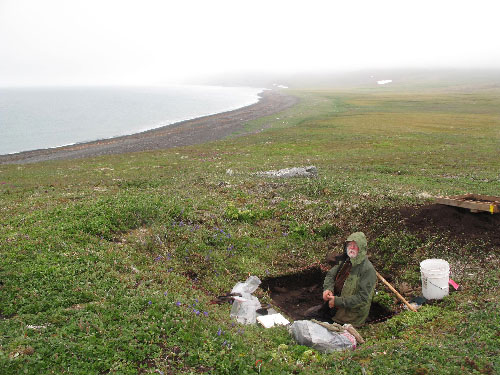
The loneliest camp on EarthBy NED ROZELL August 06, 2015
In some ways, St. Matthew, more than 200 miles from the nearest Alaska settlement (the village of Mekoryuk) is a great place to live: lush with plantlife (some of it edible); miles of coastline offering access to seabirds, their eggs, walrus, seals and fish; ample fresh water in lakes and streams.
In August 2012, Dennis Griffin examines "the Pottery House" on St. Matthew Island, the land farthest from a village in Alaska.
Dennis Griffin has visited St. Matthew twice. The archaeologist with Oregon's State Historic Preservation Office was last there in 2012 with a party of biologists hosted by the crew of the Tiglax, the 120-foot ship of the Alaska Maritime National Wildlife Refuge. While there, he dug a pit to examine one of the few weathered signs of human occupation of St. Matthew. Called "the Pottery House," the site that dates to the 1600s is on a green hillside with a view of neighboring Hall Island, three-and-one-half miles away. Today, someone's former home is a slumped square of moss the size of a mattress. Just a few steps away is the lichen-encrusted jawbone of a whale long ago dragged up from the beach, 100 feet below. Griffin wrote a paper published recently summing up what he learned by excavating a square of soil and vegetation at the Pottery House during three wet, cool days. The builders of this house first dug a floor surface into the damp ground. Following a plan perfected by Eskimo and Inuit people of Alaska's west coast, the Pottery House people then made a frame of driftwood found on the beach. Chunks of tundra sod covered the structure, absorbing rain and blocking the wind. From the main living space extended an entrance tunnel that would have helped preserve the heat from a driftwood fire and warmth escaping from bodies. If you walked up to such a structure today, you would see a green mound rising like a dome tent on a windy hillside. Griffin found many fragments of flat-bottomed, straight walled ceramic vessels. So much pottery makes Griffin think the occupants were firing their own ceramics from clay on the island. Griffin found charcoal, but he did not find signs of a hearth where people made repeated fires. He thinks this is a clue that people were not at the camp long. He also found no trash heaps outside the house, another sign of long-term residence. In the Pottery House were 16 stone tools, a flat rock possibly used as an anvil and bones from many creatures, including seabird, whale, walrus, arctic fox and polar bear. The latter lived on the island even in summer until the late 1800s. After sending out items for analysis at universities across the country, Griffin thinks he can envision the residents of the Pottery House. Despite the seasonal richness of the island, Griffin thinks the men who landed there did not intend to settle St. Matthew. He imagines two desperate walrus or seal hunters who chased their prey too far from the mainland or St. Lawrence Island. A storm blew their two-seater kayak farther from home until land was no longer visible. One day, St. Matthew appeared on the horizon and the hunters paddled hard for it. Knowing they were a long way from home and feeling the cold winds of winter, they dug into the island. When their chance to escape came after a long winter, the hunters might have boated away from the island. Or, as Griffin concluded, bits of their DNA might remain: "The eventual abandonment of the site is likely due to the return of the hunters to their homeland once the ice pack allowed them to depart," Griffin wrote in his recent paper for Arctic Anthropology. "It is also possible that the site residents never managed to leave St. Matthew, instead being killed by the large polar bear population on the island."
Since the late 1970s, the University of Alaska Fairbanks’ Geophysical Institute has provided this column free in cooperation with the UAF research community.
|
||
